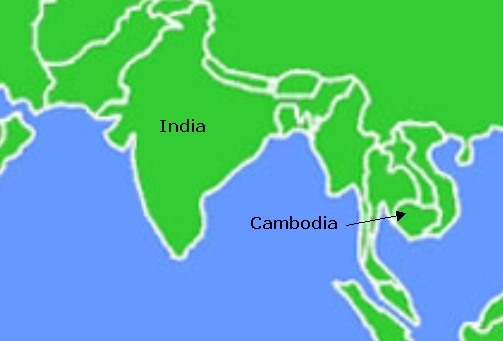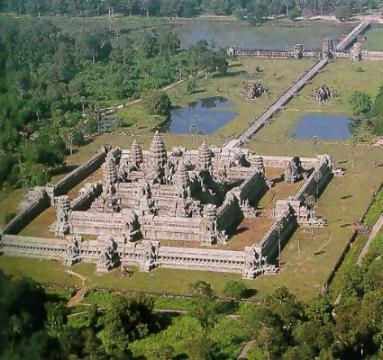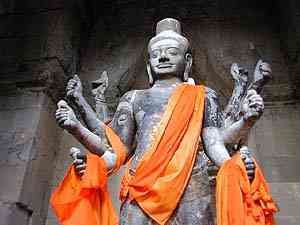Vedic Temples
 |
Cambodia
The largest religious structure in the world resides not in India but Cambodia.
There are four ages in the Vedic (Hindu) calendar, we are in the fourth one known as the Kali Yuga. Until the Islamic invasions upon India in this Kali Yuga, Vedic life was prominent not just in India, but as far east as Cambodia and as west as Saudi Arabia for thousands of years, before any other religion was even thought of. At the time it was the only religion, known as Santana Dharma (eternal religion) until recently in the last 2000 years other religions have come about.
In countries like Pakistan these temples and sacred places have been bulldozed over and the Hindu communities there ethnically cleansed, but some still remain, being looked after by their respective local communities. One such place is the now world famous Angkor Wat temple in Cambodia, today looked after by the local Buddhist community there.
Angkor Wat In Cambodia
Angkor Wat (or Angkor Vat) is a temple (or Mandir) located in north west Cambodia, in a city called Angkor. It is the largest temple in Angkor and is one of the few to have remained an active spiritual centre. The temple was originally made for King Suryavarman II in the early part of the 12th century, it was primarily run by followers of the Santana Dharma (Hindu) faith and today is run by Buddhist monks.
 |
Angkor Wat In Cambodia
The temple represents typical Cambodian architecture known as Khmer architecture, Khmer temples are typically enclosed by a concentric series of walls, with the central sanctuary in the middle. The Angkor Wat temple is a very famous symbol of Cambodia, the temple is on the national flag and it is a major tourist attraction, with remarkable structures and Gods and Devtas (demi-gods) carved on its walls. It has been used in some big budget Hollywood films.
Suryavarman II ruled between 1113-1150 and his temple was dedicated to Vishnu, with the royal palace located nearby. Sometime between the 14th and 15th century the temple was converted to Theravada Buddhist use for the majority Buddhist locals though it still has strong Hindu ties. Buddhists also have close ties and similar beliefs to that of Hindus or Vedic followers, some common ground includes karma and reincarnation. Buddhist monks have occupied the temple till today.
The temple has never been completely abandoned, but was neglected after the 16th century, recently it has had huge restoration work as it rose as a tourist attraction and was even nominated to be a part of the “new 7 wonders of the world”. Angkor Wat in itself means “city temple”. Angkor is a dialect form of the word “Nokor” which comes from the Sanskrit word “Nagara” (capital) while Wat is the Khmer word for temple. Angkor was originally the capital city at the time of Suryavarman II though now the capital of Cambodia is Phnom Penh, which is located south of the country.
A survey by the German Apsara Conservation Project found that 20% of the idols in the temple were in bad condition, erosion and deterioration over the centuries have not helped. The organisation endeavours to protect the Murthis and bas-reliefs which decorate the temple from future damage.
Angkor Wat is designed to represent Mount Meru, within a moat and an outer wall are three rectangular galleries, each raised above the next. At the centre of the temple stand some towers. Angkor Wat faces west, researchers and scholars are divided as to the significance of this. The temple is admired for the magnificence and harmony of its architecture, its wide ranging bas-reliefs, carvings, etchings and for the numerous idols adorning its walls.
 |
Vishnu Murthi At Angkor Wat
Popularity
Antonio da Magdalena, a Portuguese monk visited the temple in 1586, he was one of the first western visitors and said that it “is of such extraordinary construction that it is not possible to describe it with a pen, particularly since it is like no other building in the world. It has towers and decoration and all the refinements which the human genius can conceive of”.
The temples fame increased in the West only in the mid 19th century on the publication of Henri Mouhot's travel notes. The French explorer wrote:
“One of these temples, a rival to that of Solomon, and erected by some ancient Michelangelo, might take an honourable place beside our most beautiful buildings. It is grander than anything left to us by Greece or Rome, and presents a sad contrast to the state of barbarism in which the nation is now plunged.”
Like other early Western visitors, he did not believe that the Khmers of Cambodia could have built the temple and mistakenly dated it to the Roman period. The true history of Angkor Wat was pieced together from evidence assimilated during the recent clearing and restoration work carried out across the whole Angkor site.
In recent years Angkor Wat has become a major tourist destination, accurate figures for the temple are not available, though in 2004 the country received around 1 million arrivals, of whom according to the Ministry of Tourism, over half had planned to visit the temple. Despite the influx of tourists, relatively little further damage has occurred, other than some graffiti, while ropes and steps have been brought in to protect the bas-reliefs and floors. Tourism has also provided some funds for maintenance and upkeep of the temple, around 28% of ticket revenues across the whole Angkor site is spent on the temple. However most of the work is not carried out by Cambodian authorities, but by teams sponsored by foreign governments. |

